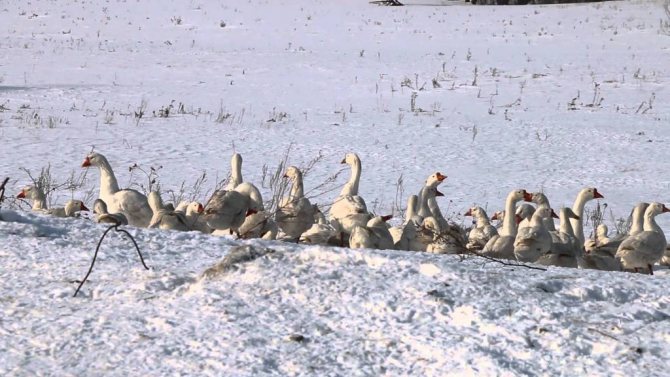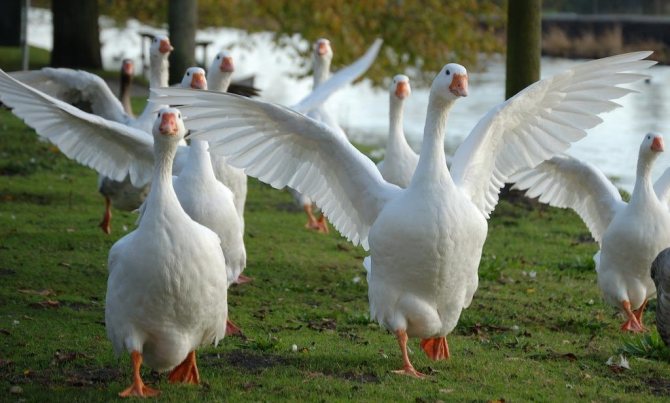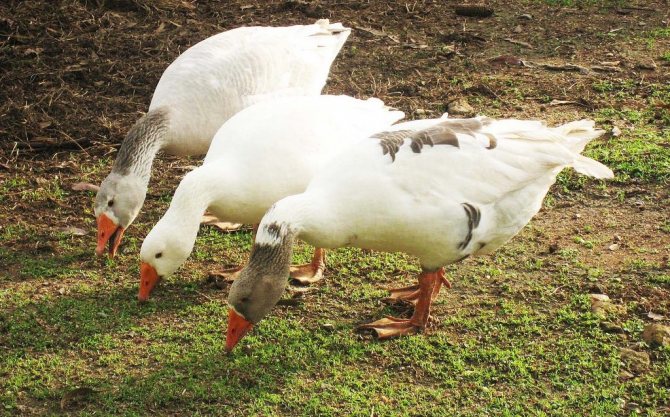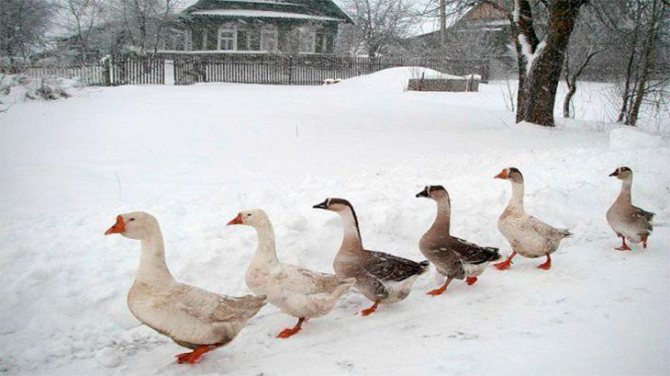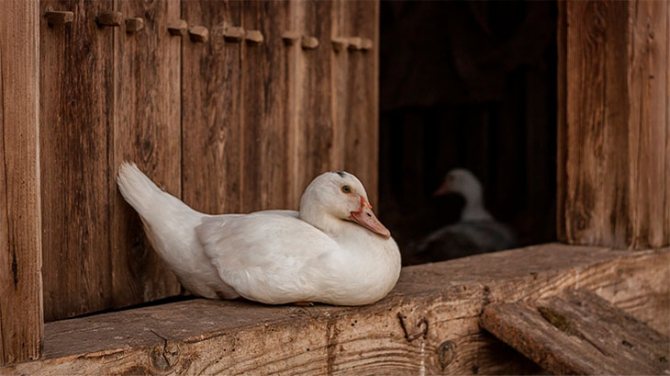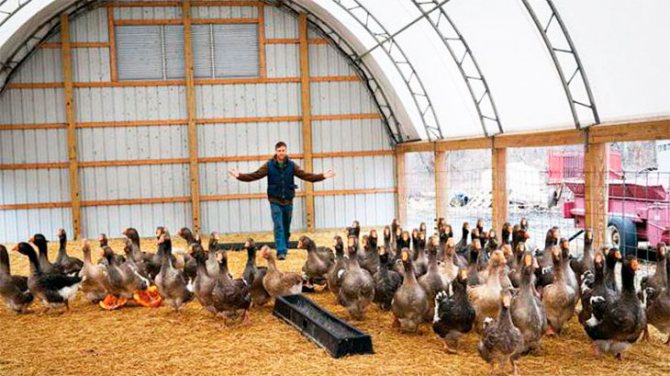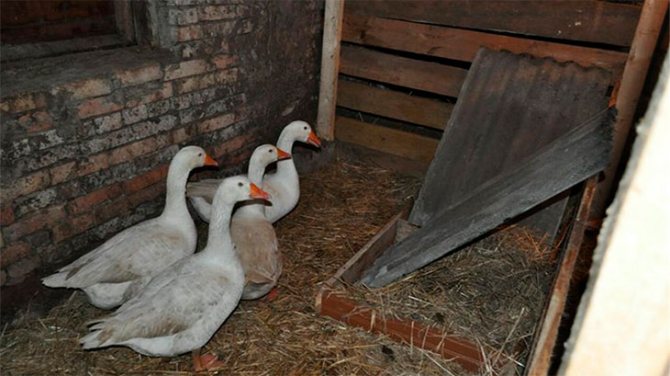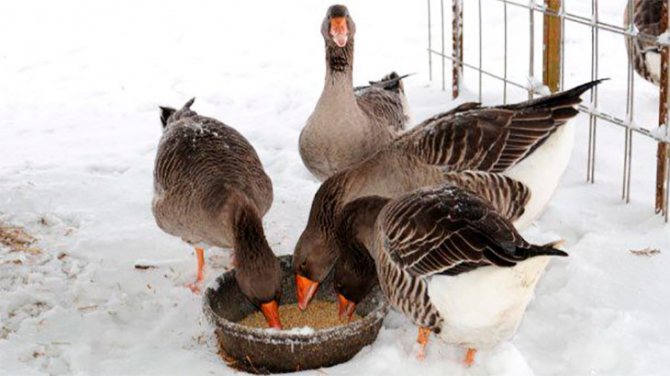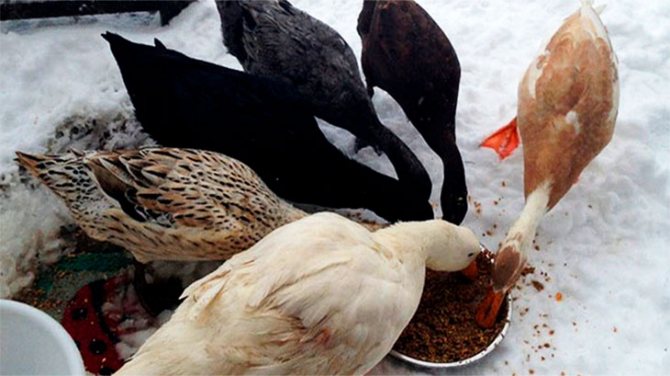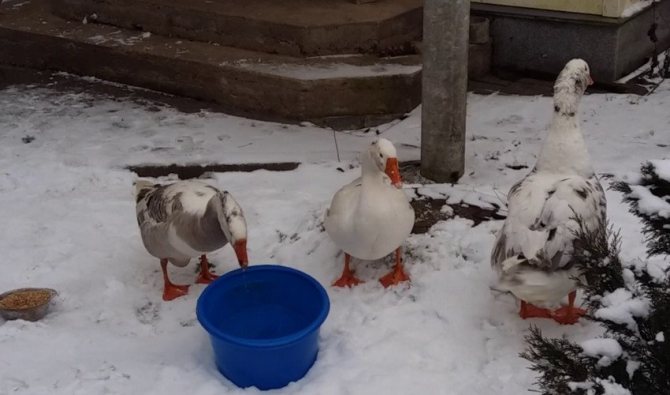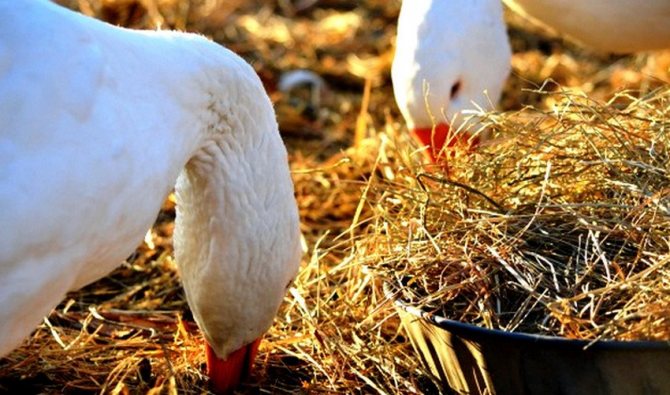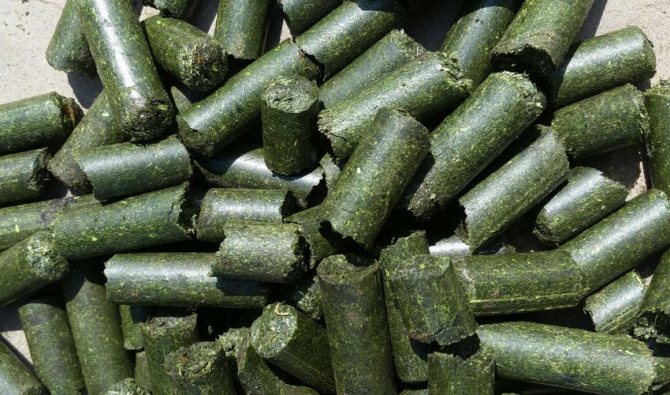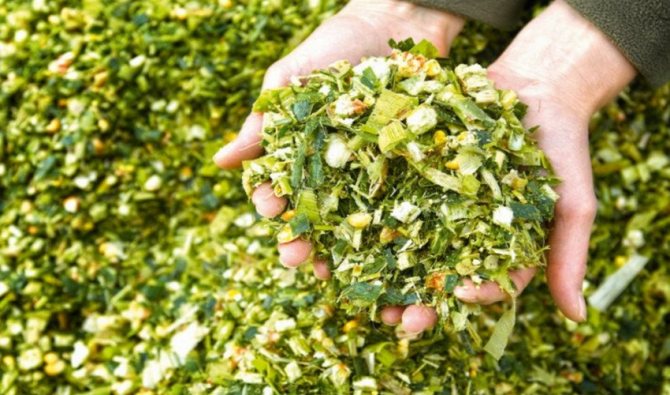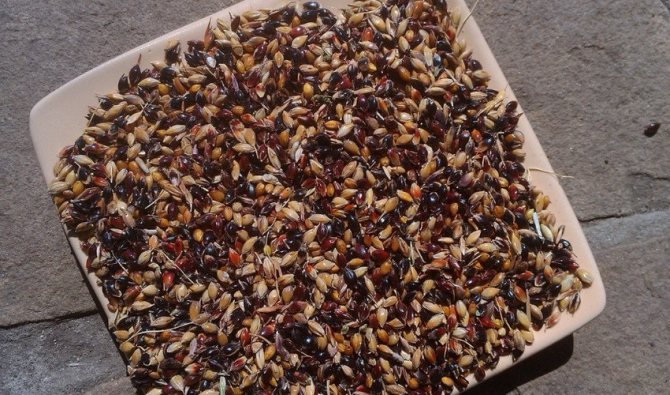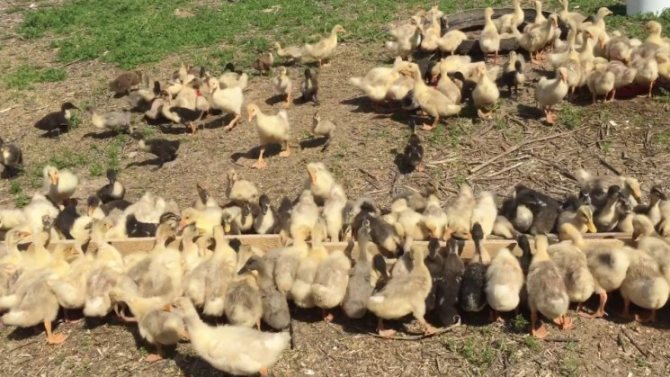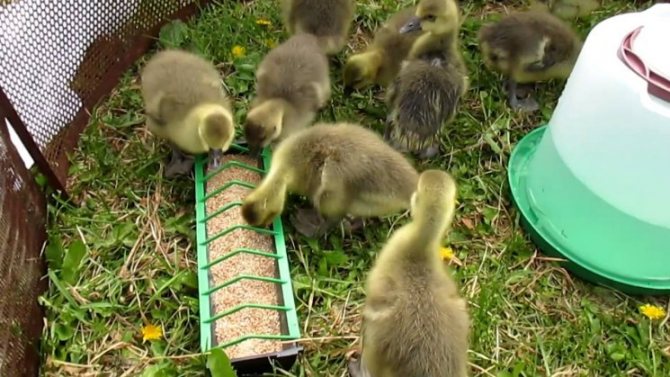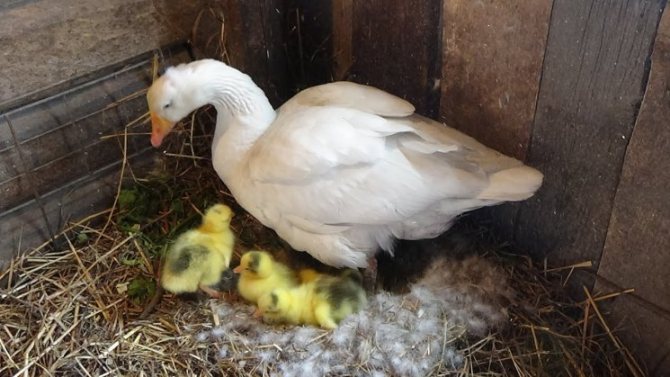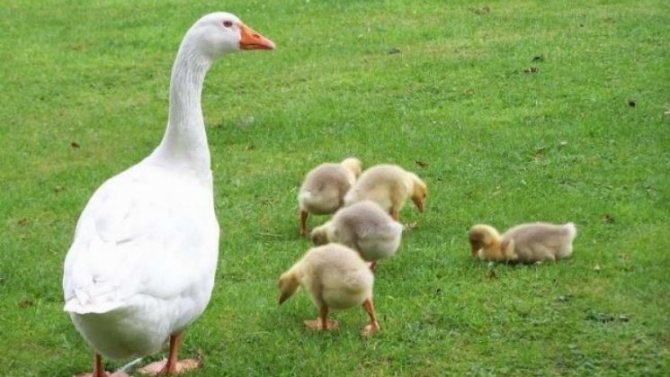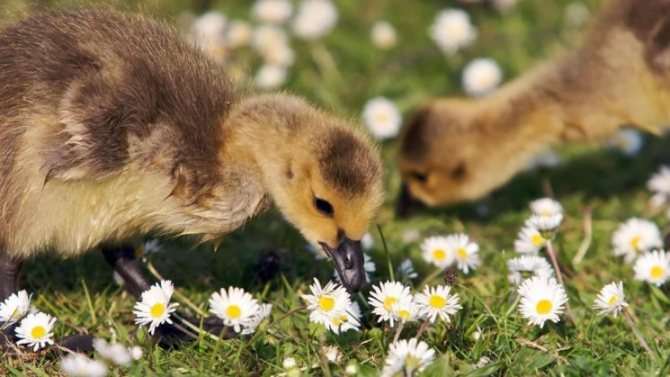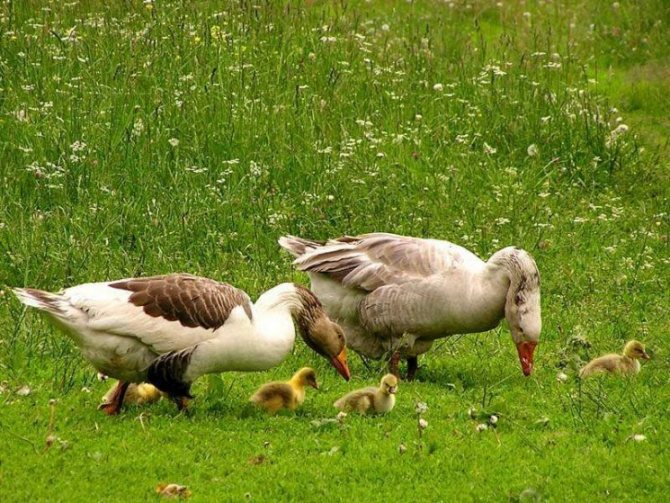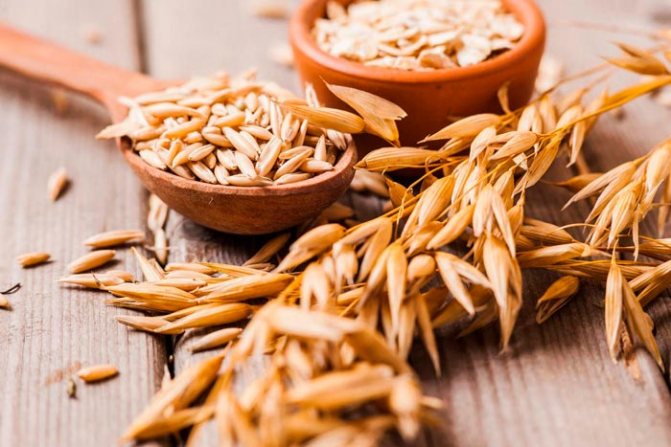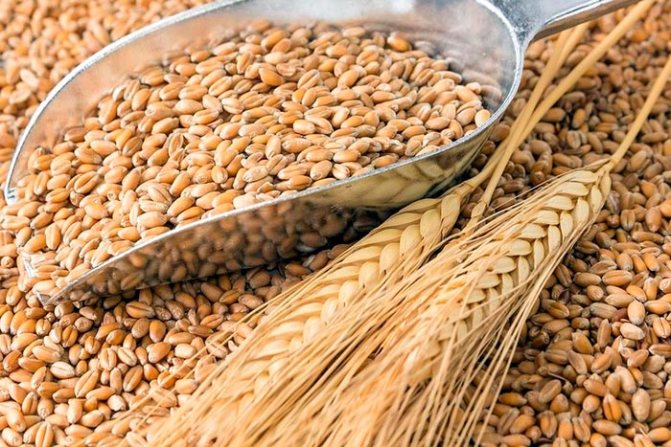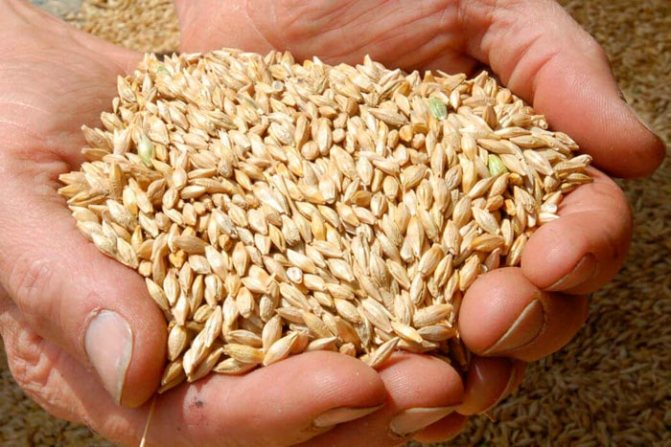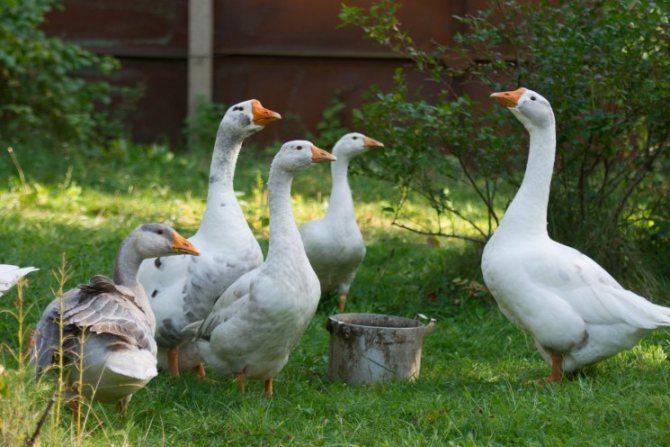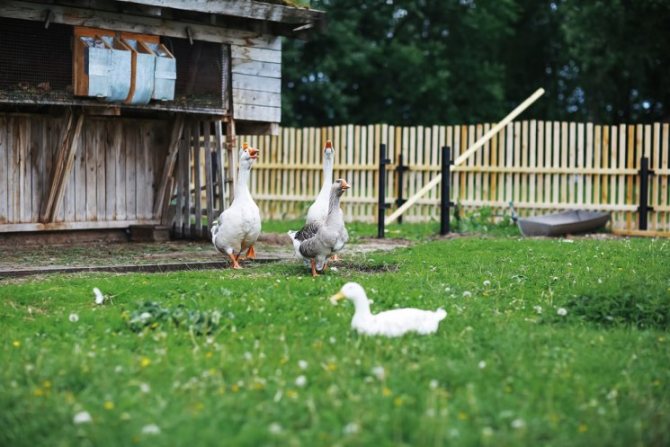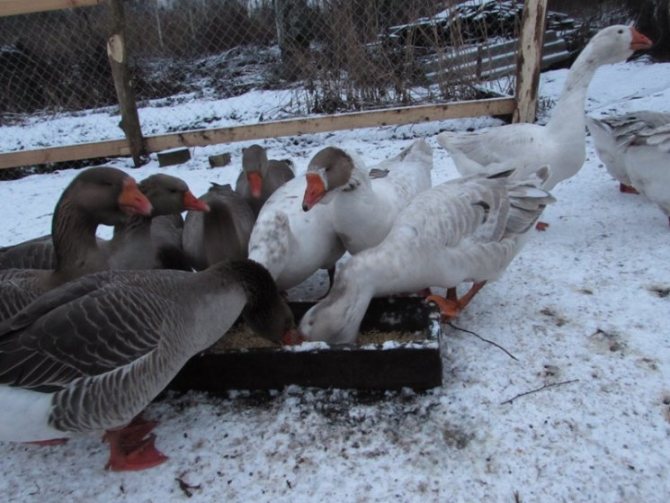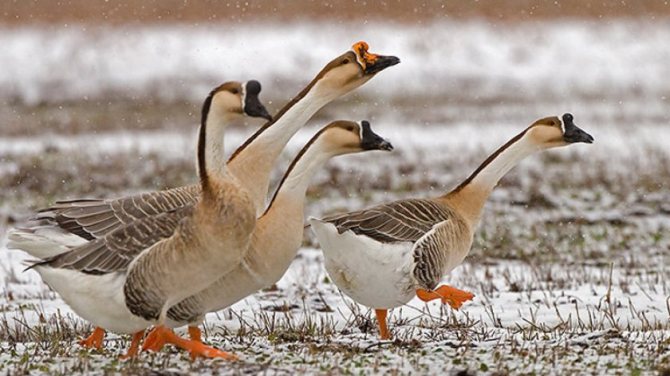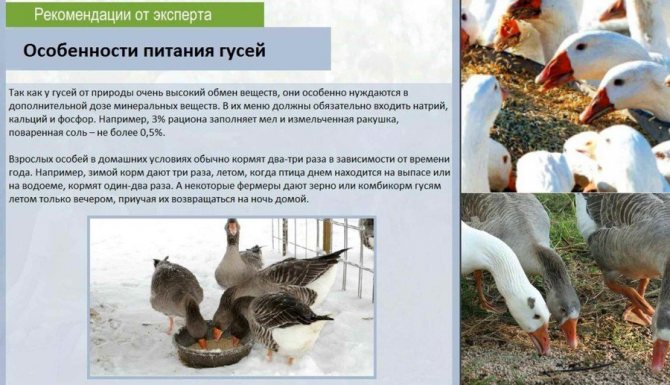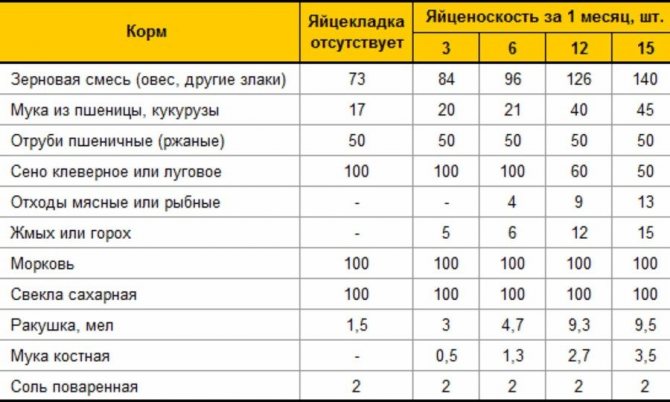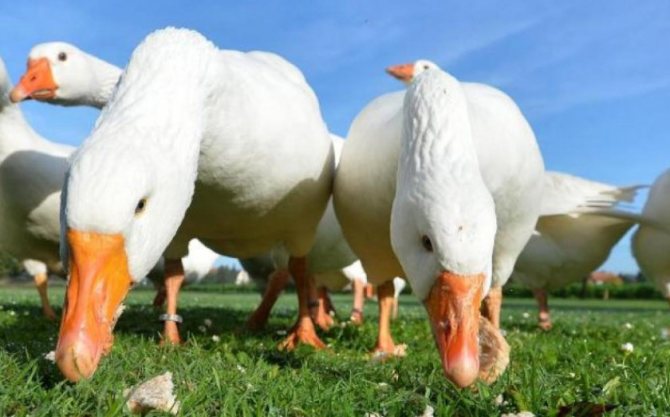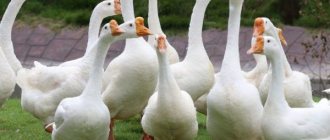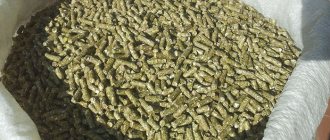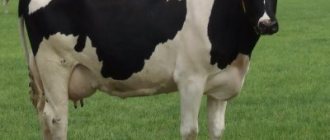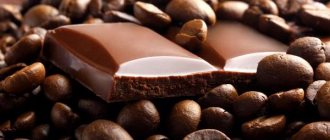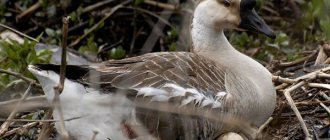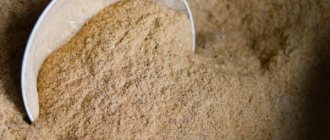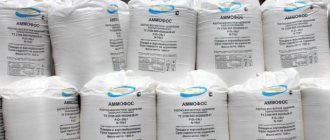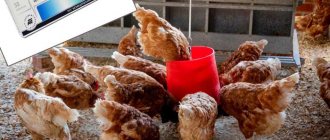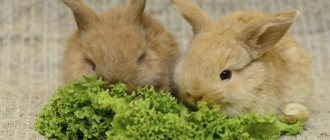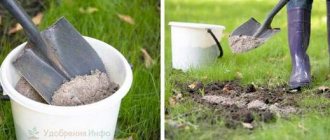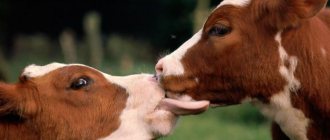Features of the content
There is an opinion that due to the good down cover, this species of birds is not afraid of frost. This is only partially true. Indeed, geese can tolerate frosts well down to -10 ° C. With good care, they do not care about -30 ° C. But there is a very important nuance - they do not tolerate dampness.
If the humidity is very high, then the feathers instantly become dirty and stick together. In this case, the down layer does not fulfill its functions. The litter in sheds quickly gets wet and dirty, as a result - the bird's feet are cold. This is a very dangerous condition for geese, and they start to get sick and even die.
Feasibility of forced feeding
Forced feeding of geese is required in cases where they cannot gain weight by a certain date. For these purposes, the individual is placed in a small poultry house. This place allows you to significantly reduce its activity.
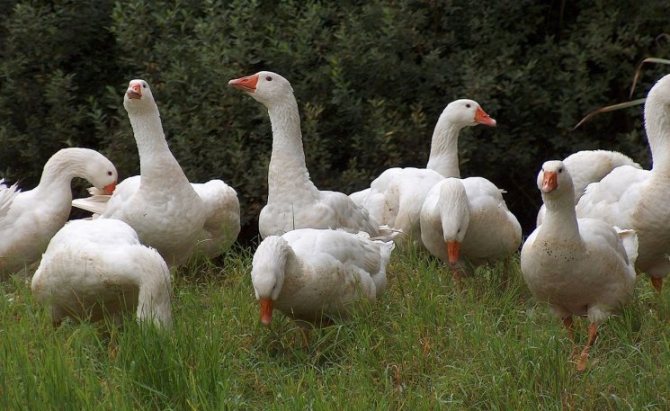
There is a special opening in the poultry house, thanks to which you can reach the green grass or other food.
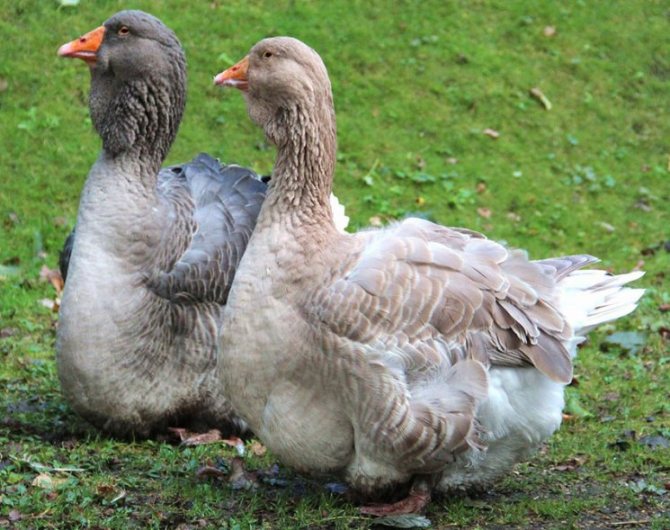

So, many people are engaged in the cultivation of waterfowl for different purposes. The most common of these is obtaining meat. Therefore, from the first days of life, a person is obliged to take care of the required maintenance of a living organism. Remember that a healthy and well-fed bird grows quickly and is capable of laying large eggs.
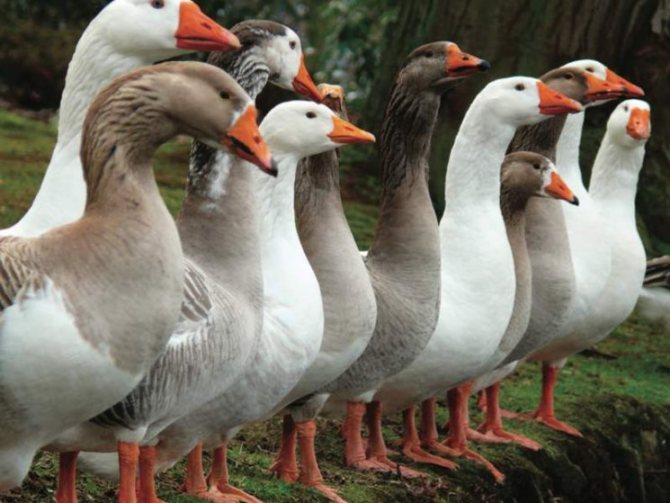

Keeping geese at home in winter
Before the arrival of cold weather, you need to prepare a room for the wintering of birds. It doesn't have to be a perfect barn. It can be built from old planks. If cracks form in it, then they can always be sealed with straw or modern sealants.
Thus, geese will be protected from wind and dampness, and this is worse for them than frost. The barn floor should be made of planks. Ground flooring or cement is not suitable - the bird's feet will freeze.
A litter made from available raw materials is placed on the floor. This could be:
- straw;
- sawdust;
- peat.
The height of the deck must be at least half a meter. In this case, the bird will not only not freeze, but will also feel comfortable. Keeping geese at home in winter requires frequent cleaning of the top layer of the flooring. Thus, moisture will not spread throughout the room.
In place of the removed layer of dirty raw materials, the same new one is put. Experienced poultry farmers have come up with a little trick so that there is no smell of ammonia in the shed. To do this, sprinkle the top layer of the flooring with superphosphate every 7-10 days. 400 g of substance is spent on 1 m2.
Keeping geese at home in winter does not require their constant stay in the barn. The bird needs to be released for a walk. Even in severe frosts, geese can stay in the open air for about 1-2 hours. The main thing is to remove the snow on the walking area so that their feet do not freeze.
Mandatory components of the diet
A large, rapidly gaining weight bird requires special attention when drawing up a diet. Geese are unpretentious, the main food for them is grass, which in the warm season they themselves perfectly find on the walks. But it should be borne in mind that at least 2 kg of green mass must fall on each of the birds per day.
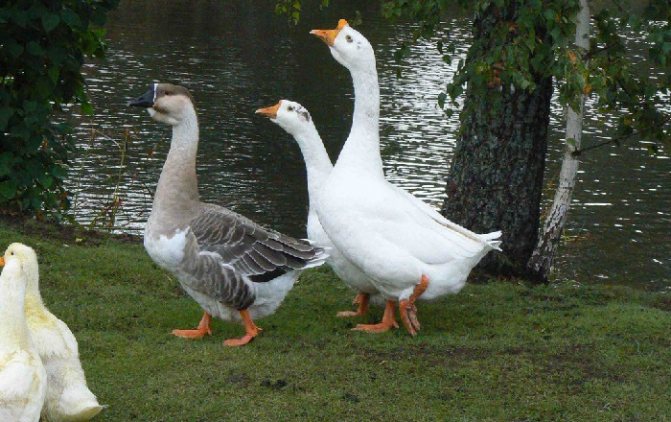

In summer, geese actively graze in meadows and eat fresh grass.
In addition, the diet must include:
- root crops: potatoes, beets, turnips - up to 1 kg per individual;
- grain mixture of barley, oats and wheat - up to 300 g;
- legumes, corn - up to 100 g;
- shell rock, chalk, mineral additives - up to 10 g.
It is also necessary to ensure that clean water, sand with small stones necessary for food processing are always available, it is advisable to give meat and bone or minced fish 2-3 times a week, include fish meal, feed yeast, vegetable fats, salt.
What to build a room for wintering
A warm and cozy room is the key to success and hassle-free keeping of geese at home in winter. For beginners, below will be presented several ways to arrange a home for birds.
Geese can spend the winter safely in a wooden room. It can be a ready-made shed or specially knocked down from boards. Also recently, breeders have been practicing keeping geese in polycarbonate greenhouses in winter.
Such a room allows light to pass through, and it becomes even warmer under the snow. There are absolutely no drafts in greenhouses, which is very important for proper wintering of birds. Some farmers send geese to winter in plastic greenhouses. This option is also possible, provided that this zone is properly arranged.
Monthly geese food
From this age, individuals begin to gain weight quickly. Therefore, they should be provided with suitable foods high in calories. One of these is considered to be grain.
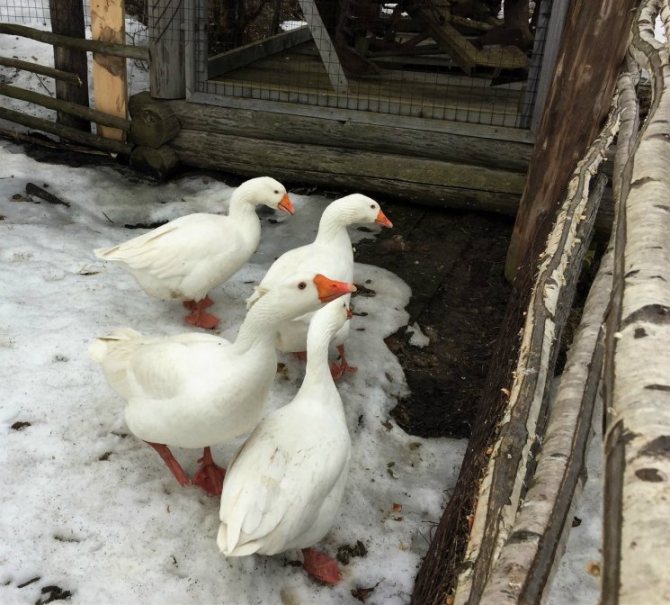

For the best effect, shells or bone meal are added to the diet. If there is a body of water nearby, it is recommended to walk geese in it. In this place, they will be able to feed on algae, saturating their body with a large supply of positive substances.
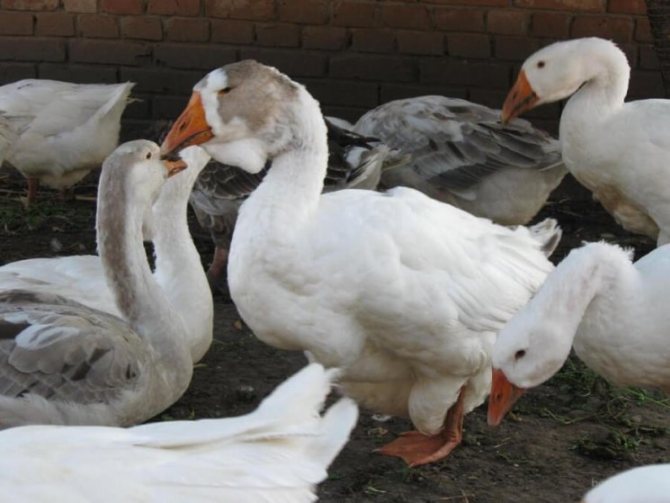

Wintering in greenhouses
This option is now quite popular among poultry owners. Keeping geese in a greenhouse in winter gives good results. Individuals continue to develop, carry and increase body weight.
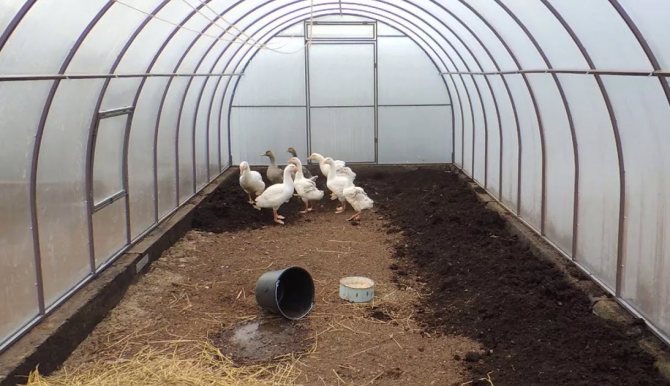

To properly equip a wintering place, you need to follow a number of rules:
- the greenhouse must sometimes be heated in severe frosts;
- strengthen the greenhouse for stability during snow and wind;
- make lighting.
These points of the plan will ensure quality keeping of geese in winter. Before settling in, the birds must be carefully cleaned there. In dust and debris, individuals will begin to hurt. You also need to provide ventilation.
It will be warmer in a polycarbonate greenhouse. This material tends to heat up quickly. It is also necessary to make a high flooring on the floor. The top layer must be removed in time.
Keeping geese in the greenhouse in winter: reviews
Farmers and owners of private estates are pleased with the opportunity to equip places for wintering birds in greenhouses. Many people think that this way you can save on fertilizer. Geese love to bury their excrement in the ground. Thus, the fertilizer will be ready by the spring.
Due to the downtime of greenhouses in the winter, it is a great idea to keep them occupied with poultry. Most often, heating and lighting have already been carried out here. Thus, it remains to equip the nests and arrange the flooring.
The owners point out that it is much more convenient to care for geese in greenhouses. During cleaning and feeding, people do not freeze and feel comfortable. Also, in the daytime, you can do without additional lighting, because the walls are good for light transmission.
What is recommended to give in the winter
Every breeder knows how to feed geese in winter. Most importantly, they need to be given various mixtures of grains, finely chopped vegetables, grass flour.
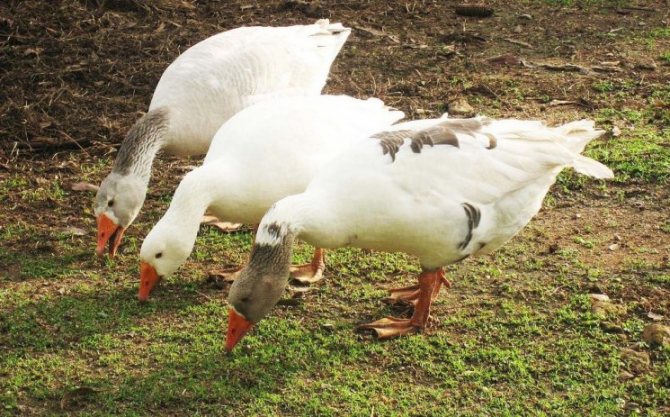

Sprouted grains are introduced since December. It is better to give them to pets before bedtime at the rate of 100 grams per unit. Along with this, the bird needs vitamins of groups A, D and E for healthy development.
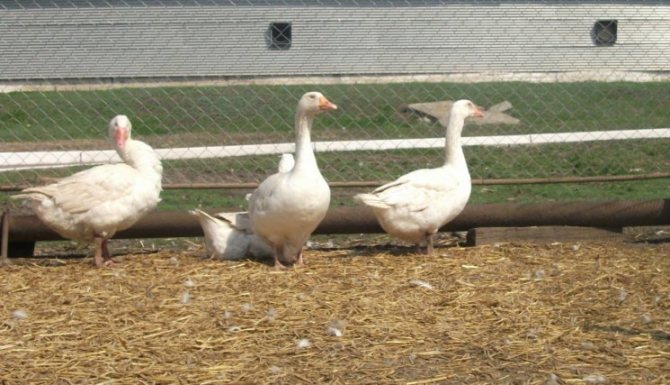

The need to walk
In the cold season, even in frosty weather, you need to let the geese go for walks. They should last at least an hour. In this way, the birds develop their paws and make it possible for the feed to digest well.
If geese lead a sedentary lifestyle, then all their reserves are deposited in fat, and not in muscles. Also, fat birds stop laying eggs, and then this process is almost impossible to establish.
In winter, you can allow geese to swim in shallow bodies of water. So they will develop their muscles, and the meat will become very tasty. At this time, the owner can calmly clean the room and ventilate it.
Seasonality
Feeding geese depends on what season it is in the yard, and, based on this, the farmer must provide the bird with everything he needs. To make everything clear, it is worth making out at what time of the year what should be given to the feathered inhabitants of the farm.
How to feed birds in spring
In winter, geese should receive the required amount of vegetables, hay, and silage. If the owner begins to notice that the bird is losing weight, then it is necessary to increase the number of crops. Mostly it is given in crushed form or as waste from production. It is best to use sunflowers, oil cakes and oil crops for weight gain.
Before egg-laying begins, it is necessary to formulate such a diet so that it is balanced in vitamins and minerals and has the maximum amount of calories. Nesting geese are rarely well-fed and should therefore get the most out of the food the owner offers. When the laying of birds begins, it is necessary to provide a sufficient amount of Ca and P by introducing the following types of feed into the diet:
- fish or minced fish;
- bone flour;
- curd products, reverse, whey, yogurt;
- feed chalk;
- shell rock;
- tricalcium phosphate.
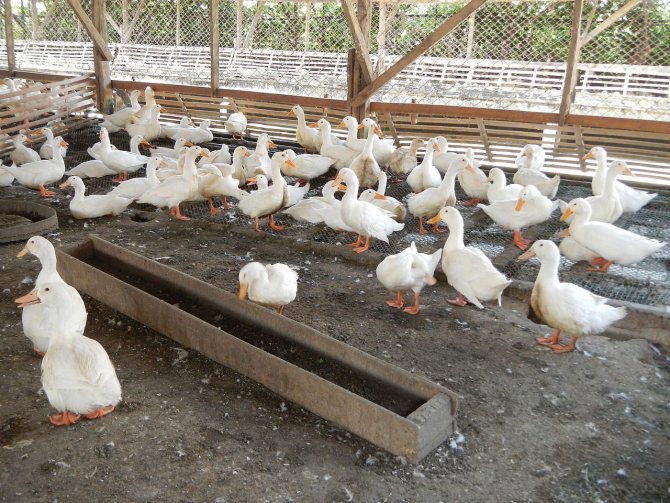

Each head should have 500 g of various vegetables: beets, carrots, potatoes. You can also give a mixture of these crops.
The spring period is characterized by the fact that the bird needs vitamins, and therefore, as soon as the greens appear, it is recommended to release the geese to pastures so that they can get everything they need from fresh grass. This practice significantly improves the general condition of the herd after long wintering.
How to feed in summer
It is at this time of the year that it is easiest to keep a bird, especially if there is a pasture with a reservoir nearby. The bird will feed not only on green mass, but also on various small inhabitants of the aquatic environment, and therefore the owner will not have to consider the nutritional value of the diet and introduce vegetable crops or mash, which will deteriorate in hot weather, as a supplement. A small feed for the night will be enough for the geese (it is necessary to calculate the portion in such a way that there is enough food for the morning, and the bird could have a little refreshment before returning to the pasture).
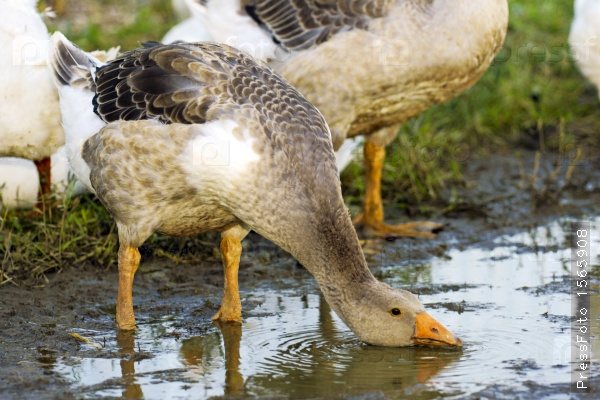

With the greatest hunting geese will eat young grass, and therefore it is recommended to periodically mow in that part of the meadow where the herd grazes - to renew the culture. Most owners divide the pasture into several parts and move the bird as needed.
In the evening, roughage is distributed, as well as mineral supplements to improve digestion. If the birds do not have access to the reservoir at night, then they must be provided with drinking water for this time.
Features of the winter diet
The grazing period lasts until the grass runs out and snow falls. If the region has winters with little rainfall, then the geese can be released to walk in the yard even in the presence of low temperatures. An adult bird will happily eat up the remaining grass and fallen leaves.
After the walking season is closed, it is necessary to divide the livestock, transplant the separately culled poultry intended for slaughter.Such geese are given a separate diet, thanks to which the individuals will quickly gain weight and eat off. There are separate feeding methods for mothers and broodstock. However, regardless of these differences, all the inhabitants of the house should receive food according to the established schedule.
How to equip a goose house
Building a barn or driving birds into a greenhouse is not enough care. The goose house must be equipped according to the rules. The equipment consists of:
- drinkers;
- feeder;
- nests.
These three elements must be in the goose house. The slots can be of standard sizes. Height and width - 50 cm and length - 60 cm. They can be made from boards, boxes or plywood.
There should be partitions between the nests, and in front you need to form a step of 10 cm. The bottom should be built of wood. Geese bury their eggs on the floor. If the floor is made of concrete or iron, the eggs will freeze. Such nests should be already in the 15-20th of January.
If possible, it is better to make perches in a separate room. This can be done with a baffle. Thus, the rest of the individuals will not be able to prevent the geese from laying eggs. Birds often fight among themselves and drive others from their nests.
It is better to collect eggs early. Birds lay eggs at night or early in the morning. By lunchtime, they may already be frozen. The room needs to be cleaned frequently. Strong gas contamination affects the number of eggs obtained from one individual.
If a brood hen has sat on the nest to produce offspring, she needs to arrange additional care. She may not even get up from the roost to eat. Thus, you need to not aggressively drive it away and add fresh feed and water.
In the opposite case, when the bird leaves the nest for a long time, it is necessary to take care of heating the eggs. It is better to feed the hen with coarse and solid food so that it does not stain the eggs.
How to feed before slaughter
Every breeder should know the intricacies of feeding geese before slaughter. The most important rule is fast weight gain. At the same time, they try to formulate the diet in such a way that about 50% of 100% of the feed falls on the grass, and another 20% is provided by soybean meal, sunflowers, ground grain, legumes.
Livestock can be fattened in two ways:
When using the first technique, the bird roams freely on the pasture land. 30 days before being sent to the slaughterhouse, the feeding is changed somewhat. Now the diet needs to be diversified with cereals and protein. As for corn, it can only be given in a certain amount, otherwise the bird begins to grow fat. The amount of grain per head is 0.4 kg. It is not recommended to turn off the lighting in the house at night - geese should eat even during these hours.
As for the second method, here the build-up of muscle and fat occurs due to the fact that individuals are limited in movement. Each goose is put in an individual cage - a box in which there is a slot for a container for food. The diet includes cereals in the form of oats, barley, wheat, corn.
During intensive feeding, some experienced poultry farmers use forced feeding. This technique allows you to significantly increase the weight of the livestock in a short time. The approximate recipe for a mix suitable for force feeding consists of different types of flour:
- corn - 20%;
- wheat - 15%;
- wheat bran - 19%;
- barley - 20%;
- oatmeal - 25%
- table salt - 1%.
The proposed mixture is used for the preparation of balls: they are slightly moistened in water, and then injected into the esophagus.
Formation of feeders
Keeping geese at home is accompanied by the arrangement of good feeders. The best option is two boards, knocked down at an angle. At the top, on the sides, you need to make additional strips that will not allow the bird to get inside.
Shields should be nailed along to prevent geese from scattering food. The feeder should be large, or several should be made so that the birds feed at the same time and do not require supplementation, otherwise it will be difficult to follow the correct diet. This threatens with excess fat gain.
The upper limit of the trough should be no lower than the back of the bird. Feeders are periodically washed and dried to avoid rotting. Separate small troughs can be built for hens.
Features of living poultry
Under natural conditions, flocks of geese settle near water bodies that are rich in aquatic flora, and in fields with lush tall grass. Keeping at home near a pond or in the presence of a massive bath is a guarantee of good health of birds and increases their productivity. Pasture keeping in summer saves a lot of money on feed.
The house should be spacious and well ventilated. It is necessary to maintain cleanliness in the room. One individual should be allocated at least 1 sq. m. These birds are not afraid of frost, they can withstand temperatures down to -10 ° C, some species are resistant to even lower rates.
The heat is much worse tolerated. With a large population of the poultry house during the hot period, the death of the livestock is possible. They keep poultry on a sawdust carpet. They need to be changed regularly or topped up more so that there is no waterlogging in the room and an unpleasant odor. From the shed, there must be an exit to the walking area and the bathhouse.
Tanks for feed and water should be installed inside the house and outdoors. You also need to install boxes with a mixture of ash and sand so that birds can clean their plumage and get rid of pests. Compliance with these rules guarantees a carcass weighing 4 kg already by the age of 2.5 months.
Drinking regime
With an insufficient amount of water or untimely replacement of the old one, the bird may get sick. The geese will also stop laying eggs. This process depends largely on the conditions of keeping individuals.
To prevent the litter from getting wet, the container with water is placed on a wooden lattice or metal sheet. Thus, excessive humidity in the room is avoided. Large buckets or any troughs can be used as containers.
You can lead a hose from a barrel of water to the drinker. In this way, fresh water will flow. The pressure should be kept to a minimum. If the bird does not drink for more than 2 days, then it completely stops rushing.
You can water the geese with melted snow water. It contains many minerals. Some owners put buckets of snow in the room.
What and how to feed the hens
In order for the number of eggs to be laid to be large, it is necessary to provide the geese with special food. It is important that the diet is supplemented with foods such as oats, legumes, carrots. In addition, there should be a lot of hay or fresh meadow grass next to the egg-laying.
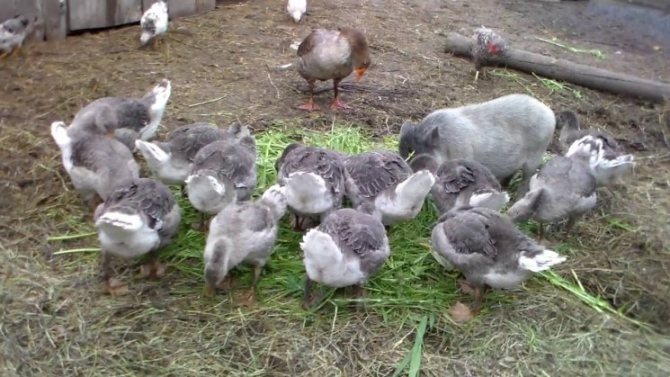

The frequency of complementary foods increases up to 4 times per day. Of these, two meals are wet and the other two are dry. Preparation of geese begins one month before the laying of eggs.
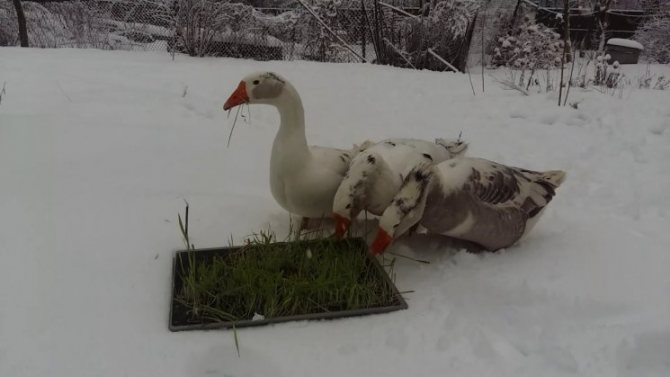

An excellent vitamin is "Trivitamin". It is introduced into the menu 7 days before. In this case, you should follow the rules of the instruction.
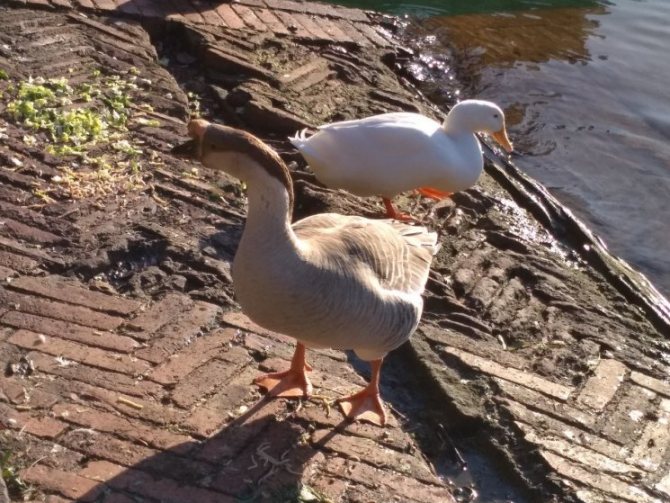

What to feed geese during cold weather
The number of feedings per day depends on the month of the season and the mode of life of the bird. Keeping geese in winter requires a specific feeding schedule. Until January, it is better to give the bird food twice a day. The first feeding should be mash, and in the evening - coarse grain.
To make a mash, you need to mix food waste and a small amount of porridge. It is best to use oat grains. This is the goose's favorite porridge. Fishmeal and grated carrots are added to this mixture.
In January the number of feedings increases up to three times. At this time, the bird spends a lot of energy - preparation for egg-laying is taking place.During this period, grain is given in the morning and evening, and the mash is given at lunchtime. With the preparation for the breeding season, the amount of feed must be increased and not be afraid of obesity in the bird. In February, it is worth adding beets and carrots to the diet of geese in large quantities to awaken the appetite.
At this time, there is an active feeding of the ganders. They waste a lot of energy on the mating process. For this, feeders are hung on the walls at a height of 90 cm. In this case, the geese will not get food. Or, before additional feeding, all birds, except for ganders, are taken out for a walk.
If the farm does not have enough grain, then you can partially replace it with potatoes. This vegetable is not so high in calories, and you need 3 times more of it. The diet must contain roughage. Hay can be given dry or steamed with the addition of oatmeal and vegetables.
Diet for feeding geese on the farm: mineral supplements
Mineral additives in the form of fine gravel, coarse sand, etc. are needed by geese to grind food in the stomach. If geese have the opportunity to feed near water bodies, then they eat various mollusks, which are caught from the silt, thus replenishing the body with calcium, phosphorus, as well as manganese, zinc, cobalt, iodine. In addition, pond and lake silt contains the entire set of micro- and macroelements. When there is no such possibility, then they install feeders with mineral dressings. As a mineral supplement, you can use eggshells, chalk, bone meal, which are a source of calcium and phosphorus.
Charcoal is fed in an amount of 1-2% of the mass of concentrates, serves to absorb gases formed in the intestines. Coal is fed ad libitum in open feeders.
Table salt is used to provide the body with sodium and chlorine.
Before feeding the geese, kitchen waste must be boiled, then chopped and added to the mash. This food group can include all garden waste, fish tails, heads, fins, tendons, meat trimmings and other food debris.
The next section of the article focuses on how to properly feed geese to get fatty liver.
Keeping birds in winter in Siberia
Some owners experiment and keep the bird in the cold outside. Scientists have proven that geese can withstand temperatures below -60 ° C. For successful wintering in the open air, you need to make a very high flooring of straw on the site so that the geese can bury themselves in it.
Keeping geese outdoors in winter presupposes an increased diet in quantity and calorie content. Thus, the geese will gain fat mass and will be able to safely endure severe frosts. It is also necessary to equip nests and places for feeding on the street.
Some owners on the street simply put three partitions without a roof so that the bird can hide from the wind. To keep the paws from freezing, they can be greased. It has been proven that large geese tolerate severe frosts better.
Keeping geese in Siberia in winter requires additional costs for feed and care. So it is more expedient to put together at least a small shed of boards without additional heating.
The nuances of indoor lighting
If you use bulbs before January-February, you can speed up the process of laying and hatching new offspring. The lighting creates additional heat and the bird gets off the right development cycle. During this period, it is better to turn on the light, observing the daylight hours. You can even reduce the lighting time of sheds by 2-3 hours.
From mid-January, bulbs can be used as a catalyst to speed up clutching and a good hatching process. At this time, the light is left on for 12 or more hours.
Feeding hens
In February, geese, before laying, should increase the proportion of green feed, minimizing grain and powdery mixtures.
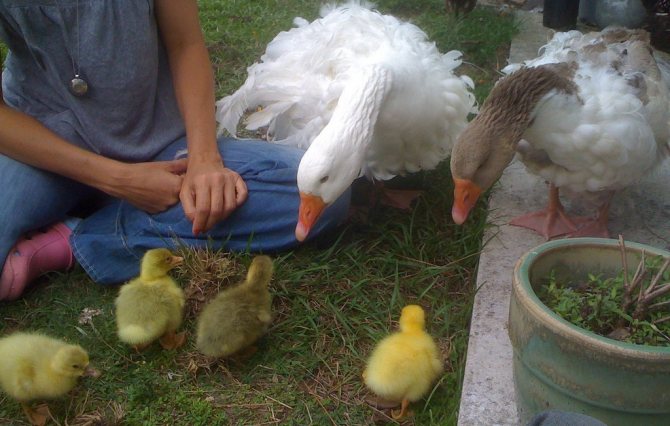

Laying geese are fed with trivitamin a week before laying.
Fish, minced meat and bone, oilseeds rich in vitamins and calcium will be beneficial. Oats, barley rich in fiber should be given sprouted. Alfalfa, clover, and meadow hay are also beneficial during this time. A week before laying hens, trivitamin is introduced into the diet, and feeding is increased to 4 per day.

